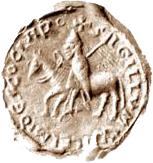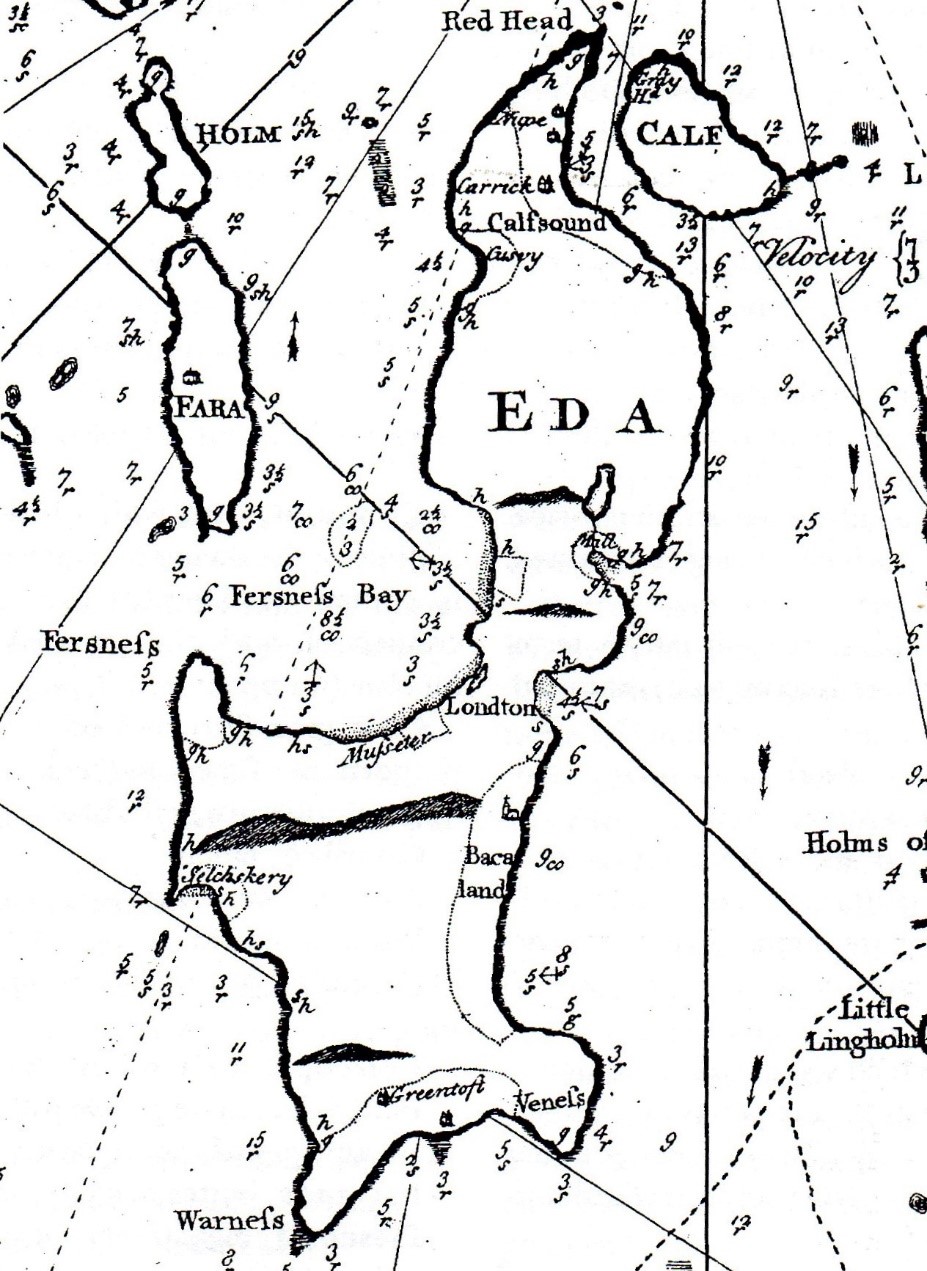Sinclair of Eday
Eday is one of the northern isles in Orkney, situated immediately west of Sanday. Only 8 miles long and 2.5 miles at its widest point, it has spectacular cliffs, home to many species of sea birds, sweeping sandy beaches and plenty of peat, which for centuries provided the fuel for fires in homes on Eday and surrounding islands. The quarry at Fersness provided the sandstone to decorate the doorways at St Magnus Cathedral in Kirkwall then, later, in the 17th century, provided stone for Earl Patrick Stewart’s castle at Scalloway in Shetland and, later still in the 19th century, it was used to build Balfour Castle in Shapinsay as well as many other individual houses in Orkney.
From the old 16th century rental of Orkney, we know that Eday was land owned by the Bishopric with, unusually, no udal (privately owned) land at all. However, local tradition goes that Eday was originally udal land, owned by the Pierson family who had borrowed money from the church, using the island as collateral. When the debt remained unpaid in 1561, Bishop Adam Bothwell leased the island to his stepfather, Oliver Sinclair of Pitcairn, who was married to the bishop’s mother, Katherine Bellenden. Oliver then sub-let the island to his nephew, Edward Sinclair of Roslin. There is another local tradition that Edward Sinclair seduced a daughter of the Pierson family and acquired the island through her. In any event, in 1564, following the arbitration of six leading Orkney men (possibly slightly biased as it included Edward Sinclair of Strom and his son, Robert of Ness), James Pierson renounced his claim on Eday and the island passed into Edward Sinclair’s hands, leasing the island directly from the Bishopric.
The first mention of Edward in Orkney documents is his being a leading part of a gathering of around eighty men, initially rioting at Kirkwall castle, and then as one of ten of those men who issued out of the castle on 5 December 1561, searching the town for Henry Sinclair of Strom and William Moodie, with the intent of killing them. It is not clear after all this time exactly what the dispute was about, but it seems likely Edward and his cohorts were supporters of Bishop Adam Bothwell, who had ruffled many feathers in Orkney since his arrival with his religious Reformist agenda. Presumably Henry Sinclair and William Moodie, as staunch Catholics, were on the opposite side of the dispute.
In 1564, Lord Robert Stewart, illegitimate son of King James V, was gifted the crown estates in the islands and thus began the rule of the notorious Stewart Earls which would soon engulf the Sinclairs of Eday. By 1575, the inhabitants of Orkney and Shetland had reached their limit under oppressive Stewart rule and complained to the King; one of the complaints was that the Earl had pursued the freemen of the islands ‘from their own houses under silence of night and putting their persons in prison’ and ‘spoiling their goods and gear’, with one of those many complainants being Edward Sinclair of Eday.
By August 1591, Edward was at Stirling securing a charter gifting his lease of Eday to his son and heir, William, whilst retaining the life-rent. Now getting old and perhaps infirm, he was protecting his family’s future; by 1597 he was described as ‘100 years old or thereby’. In June that same year, there was more trouble in the Stewart earldom and a royal letter charged all the gentlemen of Orkney and Shetland to provide surety to keep the peace; Edward had to find 2000 marks and his son William as feuar of Eday had to find £1000.
Both Sinclairs of Eday had been in debt for many years, from at least 1576 when Edward had granted a bond to Edinburgh merchants. In 1600, a Mr William Fouller had to find surety of 2000 merks not to harm William Sinclair of Eday, which may very likely have been due to an unpaid debt. Finally, in a contract drawn up on 25 May 1601, George Sinclair, the 5th Earl of Caithness, bought up Edward and William’s debts, totalling 4000 marks, which they were to repay at the rate of 400 marks annually, accept Earl George as their chief, and accept the Earl’s choice of husbands for William’s two daughters, Alesone and Elspeth. It seems from later events that the Earl of Caithness had an ulterior motive and was hoping to use the Eday Sinclairs as a weapon to beat Earl Robert Stewart with.
Sometime between 1587 and 1601, William had married Janet Halcro, the daughter of Magnus Halcro of Brugh in Rousay, the Precentor of St Magnus Cathedral, and Margaret Sinclair, daughter of Sir James Sinclair of Brecks, an illegitimate son of Sir William Sinclair of Warsetter. Janet had previously been married sometime before 1580 to Rany (Réné) Elphinstone, one of Earl Robert Stewart’s favoured servants but he died around 1587, leaving her with three young children. She then married William Sinclair of Eday and had three more children. With her first husband having been so favoured by Earl Robert, one would think Janet and her family would be protected from the oppression of the Stewart Earls rule in Orkney, but it was not to be; once the Earl of Caithness became involved in their family affairs, it brought them nothing but trouble.
Earl Robert Stewart died in 1593 and his son, Patrick became Earl in his place. Unfortunately, Patrick was even worse than his father. There was certainly no love lost between Earl Patrick and the Earl of Caithness and in 1599 both Earls had to find surety that they would suspend their quarrels. The Earl of Caithness’ father had attempted to gain the Orkney tack in 1560 and failed, however, the Sinclair Earls still had many supporters in Orkney who would rather see the illegitimate, oppressive Stewart Earls banished and replaced by the Sinclair family they knew and trusted, and now, the Earl of Caithness’s son George had a foothold on Eday. The situation was exacerbated when, as part of the deal between Earl George and the Eday Sinclairs, six or seven boatloads of ‘vagabondis, broken Highland men of Caithness’ arrived in Eday, which clearly antagonised Earl Patrick.
In 1604, William of Eday complained to the Privy Council that Earl Patrick Stewart’s men had twice invaded his lands, had besieged him in his dwelling house at Holland in Eday for 10 days in September 1603, and evicted William and Janet from their home, including imprisoning Janet when she refused to leave. William accused Earl Patrick of destroying the farm of Holland and evicting him from both Holland and Skaill in Eday, imprisoning a family messenger, preventing William’s brother James from getting onto the island, and accusing the Earl of setting his men to work the quarry at Towback and removing stone on a vast scale.
Earl Patrick’s response was to paint a picture of his necessary intervention on behalf of the elderly Edward Sinclair of Eday to protect him from physical abuse by his son. His accusation was that William had fired musket shot at his father and gripped him around the neck as if to strangle him. Additionally, the Earl claimed that Edward had sold the tack of Eday to him in return for protection, which seems unlikely since Edward only had the life-rent. The charge of abuse by William against his father may have a nugget of truth to it however, as in July 1606, Sir John Home of Coldenknowes stood caution for Oliver Sinclair, William’s brother, who was charged not to harm his father, Edward.
On 6 September 1606, Patrick, Earl of Orkney, had to find 5000 merks not to harm William Sinclair of Eday, Janet Halcro his spouse, or Alesone and Elspeth their daughters. By January 1607, James Stewart of Burray and Andrew Bruce in Wester Maill in Burray had to find caution that they would not harm William Sinclair of Eday; in 1611, Earl Patrick and Sir John Arnot pursed William for debt. On the other side of the coin, on 25 November 1612, William sued Thomas Sinclair of Lopness, the baillie of Sanday – it appears Thomas had borrowed 500 merks and the debt had not been repaid on time. [There is no definite indication of a family link between William and Thomas, but he may have been a member of the Warsetter family linked to William via his daughter Alesone’s marriage to William Sinclair of Warsetter.]
Eday’s financial woes continued; in 1617 he owed John Dalgleish, son of an Edinburgh burgess, a debt of £2750, then the following year, Robert Elphinston of Hammigar (Janet Halcro’s son by her first husband), bought up William and Janet’s outstanding debts from various Edinburgh merchants for the sum of £2224. In August 1623, the unpaid debt had increased to £2777 and by November 1623 the debt had increased again to £2800. When William of Eday died in October 1624, his stepson Robert Elphinstone and John Dalgleish continued to collect repayments of their debts from the rents of Eday until they both resigned it back to the King on 22 February 1627, and the tack was granted to John Fleming of Carwood.
Although the family eventually lost Eday, William and his brother’s descendants may have continued to live there, renting their farms from the new landlord or, indeed, given the intermarriage between the Eday and Warsetter families, they may have moved to Sanday instead. In fact, in February 1634, a George Sinclair, ‘laitlie in Farsnes [Fersness] in Eday, now in Burness in Sanday’ sold a small parcel of udal land in Skelbuster, Cross parish, Sanday, to John Stewart, Earl of Carrick. The witnesses to that transaction were Henry Sinclair, merchant in Sanday and James Sinclair in Stangasetter in Burness, who were most likely relatives. Oliver Sinclair in Fersnes, Eday, was a witness in 1614 to a charter when Malcolm Sinclair of Quendale [from Shetland] gave his son George the bull of Rapness in Westray and Langtas, Arstas, How, and 4 pennyland in Burness, in Sanday. It is possible this Oliver was William of Eday’s brother. We also know from a sasine in 1634 of Henry Sinclair the merchant, who bought several small plots of land in Overbister, Sanday, from Helen Thomson, that this time George is described as ‘in Holland in Burness’. George was still alive in 1645 when ‘George Sinclair in Holland, Sanday’ took on a 5-year tack of land in Burness from Malcolm Sinclair of Rapness [grandson of Malcolm of Quendale] but he does not appear in the 1653 rental of Sanday, so had died by then. Although we cannot be certain, it is possible that George was the son of Oliver in Fersness, the brother of William Sinclair of Eday and perhaps he acquired land in Sanday through the Eday family’s Warsetter connections when they lost the tack of Eday, unfortunately there is not enough evidence to be absolutely sure.
Nina Cawthorne
DESCENDANT TABLE
Elizabeth Sinclair ( -aft.1547) m. Sir William Cunningham of Glengarnock [Ayrshire]
Patrick Sinclair
Gilbert Sinclair
Alexander Sinclair of Cuthilton and Little Denny [Stirlingshire] ( -aft.1542) m. unknown
Oliver Sinclair of West Ravensneuk [Midlothian] ( -aft.1598)
Sir Matthew Sinclair ( -aft.1573)
Edward Sinclair of Eday (c.1508-c.1607) m. unknown (?)Pierson
James Sinclair
(?)Oliver Sinclair of Farsnes [Eday] ( -aft.1619) m. unknown
Elspeth Sinclair ( -bef.1624)
Alesone Sinclair m. c.1610 William Sinclair of Warsetter ( -c.1626)
George Sinclair ( -aft.1636) [heir to his grandfather Henry, 1636]
William Sinclair ( -aft.1636)


